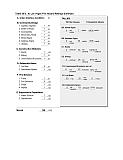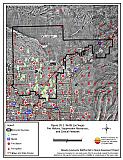30.0 North Las Vegas
30.1 Risk and Hazard Assessment
North Las Vegas is adjacent to Las Vegas in southeastern Clark County. The community hazard assessment resulted in classifying North Las Vegas in the Low Hazard category (24 points). The low rating is primarily attributed to good access and signage, adequate defensible space, sparse wildland fuels, fire resistant building materials, and sufficient fire suppression resources. A summary of the conditions that contributed to the hazard rating for North Las Vegas is included in Table 30-3 at the end of this section. The North Las Vegas community boundary is shown in Figure 30-1.
30.1.1 Community Design
The area surrounding North Las Vegas is primarily characterized as a classic interface condition. Structures abut wildland fuels and there is a clear line of demarcation between the structures and the wildland area. Approximately half of the homes are on lots of less than one acre in size; the other half are on parcels between one and ten acres in size.
- Access: North Las Vegas is accessed via Interstate 95, Interstate 93, Interstate 15, and numerous state routes. Secondary roads are generally wide, paved two-lane roads that provide adequate room for fire suppression equipment to maneuver.
- Signage: Street signs were visible on all of the roads observed in the community. Residential addresses were visible on about 95 percent of the homes observed in the interface area.
- Utilities: Utilities are both above and below ground. Utility right-of-ways are well maintained and pose a low ignition potential.
30.1.2 Construction Materials
All of the homes in the interface are built with non-combustible roofing and siding materials.
Only ten percent of the homes observed in the community have unenclosed balconies, porches, decks, or other architectural features that create drafts and provide areas where sparks and embers can be trapped, smolder, ignite, and rapidly spread fire to the home.
30.1.3 Defensible Space
Ninety-one percent of the homes have landscaping that meets the minimum requirement for defensible space in order to minimize damage to the home or property loss during a wildfire.
30.1.4 Suppression Capabilities
Wildfire Protection Resources
The North Las Vegas Fire Department has six stations throughout its 84-square mile coverage area. The stations are staffed by 147 career firefighters. Automatic aid is available from the Clark County Fire Department and the Las Vegas Fire Department through the Clark County Fire Alarm Office. Nellis Air Force Base, the Nevada Division of Forestry, and the Bureau of Land Management also provide mutual aid assistance to the North Las Vegas area.
The North Las Vegas Fire Department is primarily equipped and trained to respond to urban incidents and emergencies. Specialized equipment and personnel trained in standard operating guidelines for wildland fire suppression in the North Las Vegas wildland-urban interface currently comes from outside agencies.
In the city limits of North Las Vegas, there is no formal first alarm brush fire dispatch because of the very limited brush within the city limits. Normal dispatch to a brush or grass fire at the wildland-urban interface would be one Type I structure engine (Chief Tarbett 2004).
| Type of Equipment | Amount of Equipment | Resource Location |
|---|---|---|
| Type 1 Structure Engine | 1 | North Las Vegas Fire Department |
| Source: Chief Tarbett, pers. comm., 24 March 2004. | ||
Mutual aid can be requested from the US Forest Service and the Bureau of Land Management through the Las Vegas Interagency Communications Center. The Nevada Division of Forestry also provides mutual aid dispatched from the Sierra Front Interagency Dispatch Center in Minden, Nevada, which locates the nearest available fire suppression resource according to incident command and computer aided dispatch protocols. It is important to note that these resources can be assigned to other emergency incidents during the fire season.
Water Sources and Infrastructure
Water available for fire suppression in North Las Vegas includes fire hydrants structures with a minimum flow capacity of 500 gpm within 500 feet of.
Fire Protection Personnel Qualifications
Firefighters are trained to the State of Nevada Fire Marshal Firefighter I and II and some are trained to EMT-B. The North Las Vegas Fire Department does not offer wildland fire training.
Work Load
The North Las Vegas Fire Department generally responds to 20,000 calls annually. Approximately 82 percent are emergency medical calls. Occasionally they are called to small grass fires.
Financial Support
Financial support for the North Las Vegas Fire Department comes from the City General Fund.
Community Preparedness
The City of North Las Vegas has an Emergency Operations Plan. This plan is prepared by the Emergency Management Office of the Fire Department and is updated as needed.
The North Las Vegas Fire Department reviews development plans to ensure compliance with the 2000 UFC fire code.
30.1.5 Factors Affecting Fire Behavior
The City of North Las Vegas is characterized by flat terrain. There are a few sites with brush accumulations within the city limits. The vegetative community around the North Las Vegas area is Mojave Desert shrub. Fuels consist of annual grasses and bursage. Heavier fuels occur in the washes. The fuel hazard in the interface area was considered low.
30.1.6 Fire Behavior Worst-case Scenario
The worst-case for a wildland fire would be a fire starting near a construction site in a wash with dense fuels or somewhere within the city in a brushy area. A wind driven wildland fire could send flying embers into the construction sites, igniting woody debris or buildings under construction. Conversely, a fire originating at a construction site could spread into the adjacent wildland areas. A rapid initial attack should be sufficient to control a fire under these conditions.
30.1.7 Ignition Risk Assessment
North Las Vegas has a very low wildfire ignition risk potential. The area does not have a history of large wildfires and the few recorded historical ignitions indicate that low, sparse brush in and around the community is not conducive to frequent or intense fires.
30.2 Risk and Hazard Reduction Recommendations
The hazard reduction recommendations for North Las Vegas focus on weed control and firefighter training.
30.2.1 Defensible Space Treatments
Defensible space treatments are an essential first line of defense for residential structures. The goal of the treatments is to significantly reduce or remove flammable vegetation within a prescribed distance from structures. (Refer to Appendix E for the recommended defensible space area) Defensible space reduces the fire intensity and improves firefighter and homeowner chances for successfully defending a structure against oncoming wildfire.
Property Owners
- Remove debris and flammable vegetation from within the defensible space area.
- Immediately dispose of cleared vegetation when implementing defensible space treatments. This material dries quickly and poses a fire risk if left on site.
- Maintain this defensible space as needed to keep the space lean, clean, and green.
- Maintain the areas underneath decks, porches, etc. free of weeds and other flammable debris to prevent sparks lodging, smoldering, and spreading fire to the home.
- Clear vegetation and combustible materials around propane tanks for a minimum of ten feet.
30.2.2 Fire Suppression Resources
North Las Vegas Fire Department
- Provide all firefighters with basic wildland fire training and equipment as described in the National Wildfire Coordinating Group (NWCG) Wildland and Prescribed Fire Qualification System Guide (PMS 310-1). Provide annual wildland firefighting refresher training.
30.2.3 Fuel Reduction Treatments
North Las Vegas Fire Department
- Establish and enforce a brush clearance program to target the few fuel hazard areas remaining within the community.
30.3 Summary of Recommendations
| Involved Party | Recommended Treatment | Recommendation Description |
|---|---|---|
| Property Owners | Defensible Space | Remove debris and flammable vegetation from within the defensible space area according to the guidelines in Appendix E. Immediately dispose of cleared vegetation when implementing defensible space treatments. This material dries quickly and poses a fire risk if left on site. Maintain this defensible space as needed. |
| North Las Vegas Fire Department | Fire Suppression Resources and Training | Provide all firefighters with basic wildland fire training and equipment and provide refresher training annually. |
| Fuels Reduction | Establish and enforce a brush clearance program to target areas with brushy fuels within the community. |
Table 30-3. North Las Vegas Wildfire Hazard Rating Summary |
 |
Figure 30-1 North Las Vegas Fire History, Suppression Resources, and Critical Features |
 |
